 Front row from left: Nico Chasin, Arthur Guo, Logan Wu.
Front row from left: Nico Chasin, Arthur Guo, Logan Wu.2nd Row: Aydin Turgit, Max Lu, Nathaniel Shuman, Martha Samadashvili, Christopher Woojin Yoo, Nastassja Matus, Jason Wang, Evelyn Zhou.
3rd row: Akira Nakada (me), Jason Daniels, Wesley Wang, Naomi Bashkansky.
Day 1:
Today was my first day at camp. The club blew my mind. There were huge screens projecting the latest top ICC games, there were wooden chess boards all over the place, and the club looked beautiful. Our teacher for the first day at camp was IM Armen Ambartsoumian, United States World Youth coach and former Armenian national team coach (you know, the country that almost always is at the top of the list in the Chess Olympiad). Our first lesson was on a very common opening that still confuses strong players as to why it is so sound, the Ragozin. Red flags are thrown up around the 5th move in some variations! 1.d4 Nf6 2.Nf3 d5 3.c4 e6 4.Nc3 Bb4 5.Qc2 Nc6 For anyone who knows the Queen’s Gambit Declined reasonably well, seeing someone put the knight on c6 makes them cringe. The plan would be to put the knight on d7 and fianchetto the bishop with b6 bb7, then c5 comes and you fight for the center. Nevertheless, this opening has proven its soundness among the top players in the world. The main part of the lesson, though, was not the opening, it was the importance of knowing the transpositions in your opening. You could memorize all the lines in the world and not know how to play the middle and end game with them and you would lose every time. Here is an example from a variation in the Slav.[pgn][Event "FIDE World Cup 2005"]
[White "Harikrishna, Penteala"]
[Black "Vescovi, Giovanni P"]
[Result "1-0"]
[ECO "D19"]
[WhiteElo "2673"]
[BlackElo "2646"]
[PlyCount "83"]
[EventDate "2005.11.27"]
[EventType "k.o."]
[EventRounds "7"]
[EventCountry "RUS"]
[Source "ChessBase"]
[SourceDate "2006.04.04"]1. c4 c6 2. d4 d5 3. Nc3 Nf6 4. Nf3 dxc4 5. a4 Bf5 6. e3 e6 7. Bxc4 Bb4 8. O-O
Nbd7 9. Qe2 Bg6 10. e4 O-O 11. Bd3 Bh5 12. e5 Nd5 13. Nxd5 cxd5 14. Qe3 Be7 15.
Ng5 Bxg5 16. Qxg5 Bg6 17. Be2 Qxg5 18. Bxg5 {[pgndiagram] This position was more or less reached by force, and in a supposedly “dead drawn” position, Harikrishna outplayed a strong grandmaster because he knew the ideas of the opening. His opponent knew the theory very well, but when they had to play chess, Harikrishna was able to win.} 18...Rfc8 19. Rfc1 a6 20. h4 f6 21. exf6
Nxf6 22. f3 Bc2 23. Ra3 Kf7 24. Kf2 Rc6 25. b4 Nd7 26. b5 Rcc8 27. a5 axb5 28.
Bxb5 Nf6 29. Ra2 Bb3 30. Rxc8 Rxc8 31. Rb2 Bc4 32. Bxc4 dxc4 33. Rxb7+ Kg6 34.
a6 Rc6 35. a7 Ra6 36. Bxf6 Kxf6 37. Ke3 Ra5 38. Kd2 Ra4 39. Kc3 h5 40. g4 Kg6
41. g5 Kh7 42. Re7 1-0[/pgn]
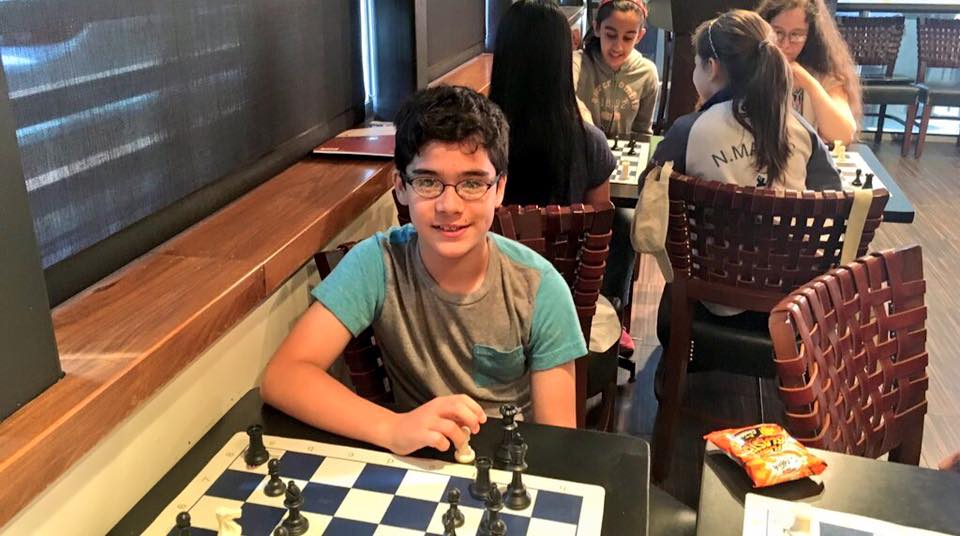 Akira
AkiraWhite to move and win.
[pgn][White "Short, Nigel D"]
[Black "Timman, Jan H"]
[Result "1-0"]
[ECO "B04"]
[WhiteElo "2660"]
[BlackElo "2630"]
[Annotator "Rogers,I"]
[SetUp "1"]
[FEN "2r2rk1/1bpR1p2/1pq1pQp1/p3P2p/P1PR3P/5N2/2P2PPK/8 w - - 0 32"]
[PlyCount "7"]
[EventDate "1991.10.??"]
[EventType "tourn"]
[EventRounds "14"]
[EventCountry "NED"]
[EventCategory "17"]
[Source "ChessBase"]
[SourceDate "1992.02.01"]32. Kg3 $1 Rce8 33. Kf4 $1 Bc8 34. Kg5 $3 {and Black resigned. After} Bxd7 35.
Kh6 {Black cannot prevent Qg7#} 1-0[/pgn]
The first day wasn’t all tests and lectures though. Greg and Aviv also organized a bullet tournament with us. Slowly the players went from fifteen all the way down to two: it was Aydin Turgit vs Nico Chasin. The game was very tense, but at the end Aydin pulled off the win in a rook endgame with his two rooks on the second rank.
Day 2:
Our teacher for today was again Armen, but today we were taught about a very interesting line in the Slav. The line is a forced transposition into an endgame. That is crucial because if you know the ideas in the endgame, the line could serve you well (I showed the position in Day 1, Harikrishna-Vescovi). Another example of the importance of knowing your opening’s ideas all the way to the endgame is evident in the game Navara-Jobava.[pgn][Event "?"]
[Site "?"]
[Date "????.??.??"]
[Round "?"]
[White "Navara"]
[Black "Jobava"]
[Result "1-0"]
[ECO "B65"]
[PlyCount "83"]1. e4 c5 2. Nf3 d6 3. d4 cxd4 4. Nxd4 Nf6 5. Nc3 Nc6 6. Bg5 e6 7. Qd2 Be7 8.
O-O-O O-O 9. f4 Nxd4 10. Qxd4 Bd7 11. Bxf6 Bxf6 12. Qxd6 Bc6 13. Qxd8 Rfxd8 14.
Bb5 Bxc3 15. Bxc6 Bxb2+ 16. Kxb2 bxc6 17. Rxd8+ Rxd8 18. Kc3 {[pgndiagram]Once again the opening transposes more or less by force into an endgame. Now it is not a test of memorization, but rather of who knows the ideas better. Anyone can memorize an opening but you need to learn your opening’s ideas. Navara won this game relatively easily and without noise from this position. Here is the notation for the game.} 18...Kf8 19. Rb1 Ke7
20. e5 h5 21. a4 Rd5 22. Rb7+ Rd7 23. Rb8 Rd8 24. Rb4 Rd5 25. g3 Rc5+ 26. Kb3
Rd5 27. c4 Rd2 28. a5 Kd8 29. Rb8+ Kc7 30. Rf8 Rd7 31. Kb4 a6 32. Kc5 g6 33.
Ra8 Kb7 34. Rf8 Kc7 35. h3 Kb7 36. g4 hxg4 37. hxg4 Kc7 38. Ra8 Kb7 39. Rh8 Kc7
40. Rh1 Rd2 41. Rh7 Rd7 42. g5 1-0[/pgn]
Along with the lecture, we also had a field trip to the Chess Hall of Fame! I thought we were going to have to take a bus for an hour to get there, but it turned out that the Hall of Fame was just across the street. In front of the door there was a huge chess set that I played on for some time, but then we went in the building and took a tour of the museum.
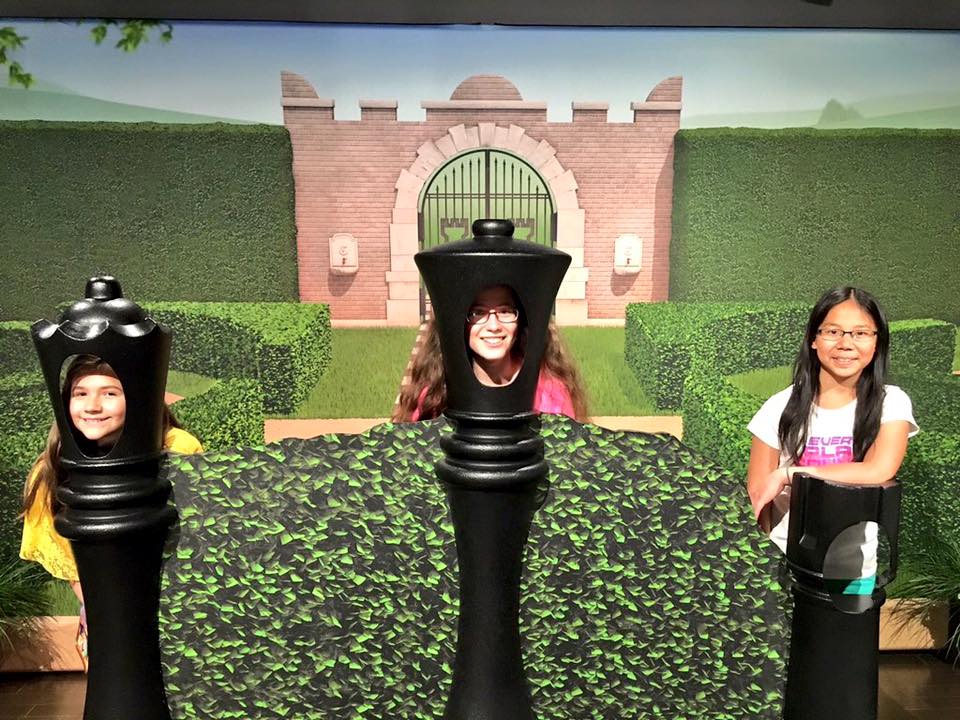
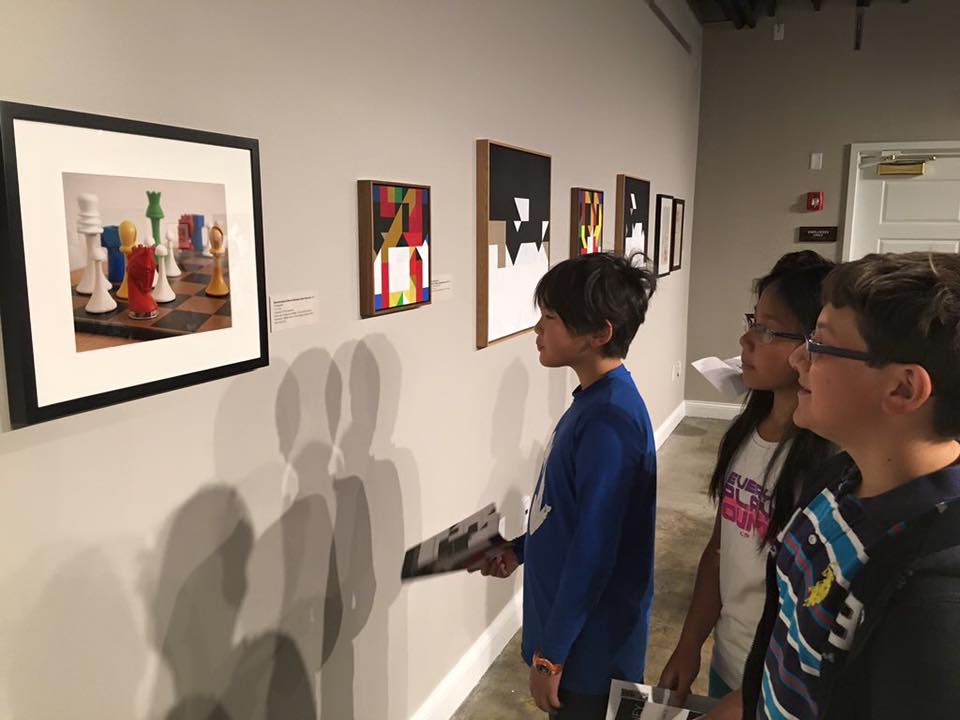 I had a blast that day but you can’t relax forever, you have to buckle down and learn. Once we came back to the camp, Aviv, who thought that Greg should have a taste of his own medicine (just kidding) had made another test for us. This test was much more tactical than Greg’s test was. The last part of the day was the start of the blitz tournament.
I had a blast that day but you can’t relax forever, you have to buckle down and learn. Once we came back to the camp, Aviv, who thought that Greg should have a taste of his own medicine (just kidding) had made another test for us. This test was much more tactical than Greg’s test was. The last part of the day was the start of the blitz tournament.
Day 3:
We started off the day by talking a bit about ourselves and our chess. Greg gave us each six questions to answer on that topic. Some of them were, “What openings give you the most trouble?” “What do you do for your chess?” Or rather, “What do your parents do for your chess?” There was also, “What are your strengths and weaknesses?” This was a really interesting session. I knew most of these kids from World Youth and from other big tournaments, but I never got a chance to hear them talk about their strengths and weaknesses and how they study. In a way it was also very motivating for me. To hear that all of these kids are working so hard to get better made me want to work harder as well. After our conversation Greg gave us another intuition test like his other one. Here is one problem that I should have gotten right (hint: superfluous knights, knights that double each other).White to move.
[pgn][Event "Continental Class Championship 2007"]
[White "Shahade, Gregory P"]
[Black "Kaufman, Larry C"]
[Result "1-0"]
[ECO "A37"]
[WhiteElo "2449"]
[BlackElo "2406"]
[SetUp "1"]
[FEN "r3k2r/pp1q1p1p/3pp1p1/2pP1n2/2Pn4/2N2NP1/PP2PP1P/1R1Q1RK1 w kq - 0 16"]
[PlyCount "35"]
[EventDate "2011.10.06"]
[EventType "swiss"]
[EventRounds "9"]
[EventCountry "USA"]
[Source "ChessBase"]
[SourceDate "2011.10.28"]16. Nd2 Ne7 17. Nde4 O-O-O 18. Nf6 {and the game continued:} Qc7 19. b4 Kb8 20.
e3 Ndf5 21. Nb5 Qc8 22. e4 Ng7 23. Qa4 a6 24. Nc3 Ne8 25. bxc5 dxc5 26. Nxe8
Rhxe8 27. Qxa6 exd5 28. exd5 Nf5 29. Rb6 Nd6 30. Rfb1 Re7 31. Nb5 Nxb5 32.
R1xb5 Rdd7 33. Ra5 1-0[/pgn]
Earlier that day, Greg had scheduled a pool party. We had a blast at the pool playing a bunch of pool games like Sharks and Minnows, and Marco Polo. Here is a photo from the pool.
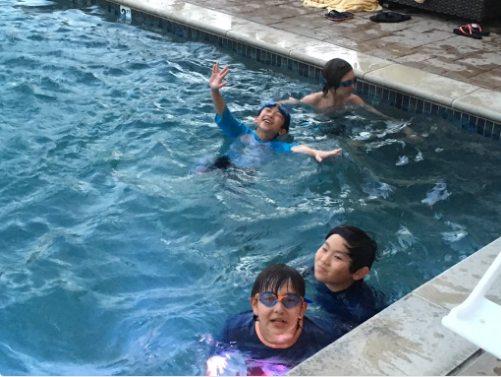
Day 4:
Today was the last day of camp and I had to leave early because I had school the next day. I had one last lesson from Armen, and he decided that he would give us an intuition test. This one was very different. We had one minute to solve each of the ten problems and then after we wrote our answers, we would have an additional five minutes to calculate lines and write another answer. This test would help us see if we should trust our intuition, or if we should calculate further to find the best move.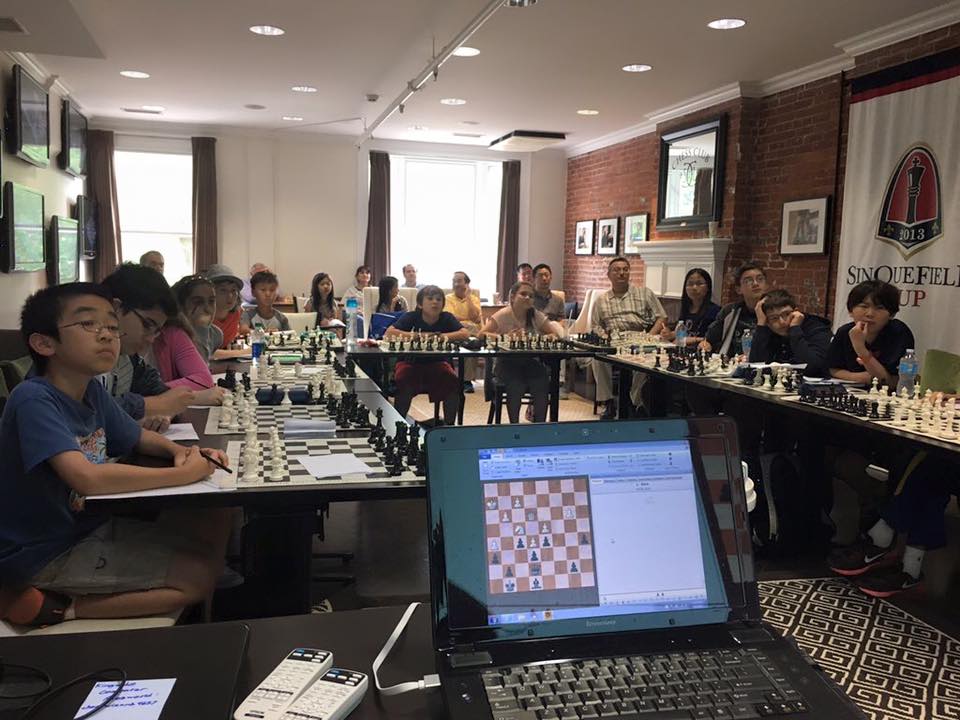 The last stop of the camp was the downstairs area. That is where all of the filming is done, where GM Maurice Ashley does his interviews, and where Jennifer Shahade and Yasser Seirawan commentate on the games in progress. There is even the famous brown couch that you see on TV (although it looks more comfy on TV). The best part of the trip downstairs was getting to film our own analysis of a made up game live from the Saint Louis Chess Club. If you want to check out the video, it is on U.S Chess School’s twitter.
As it turned out, our flight got delayed 4 hours! We could have stayed for the simul and finished camp if we had known that. As we waited, about two hours later, the Shumans came to the airport and saw us at the gate. Nate and I played around for I while. Then more people came -- it was Evelyn Zhou and Nastassja Matus. I guess I was still in St. Louis. We played bughouse for a while and then our gate started handing out pizza since the plane was so delayed! My mom and I then got on our flight and at 2:00 in the morning got home.
The last stop of the camp was the downstairs area. That is where all of the filming is done, where GM Maurice Ashley does his interviews, and where Jennifer Shahade and Yasser Seirawan commentate on the games in progress. There is even the famous brown couch that you see on TV (although it looks more comfy on TV). The best part of the trip downstairs was getting to film our own analysis of a made up game live from the Saint Louis Chess Club. If you want to check out the video, it is on U.S Chess School’s twitter.
As it turned out, our flight got delayed 4 hours! We could have stayed for the simul and finished camp if we had known that. As we waited, about two hours later, the Shumans came to the airport and saw us at the gate. Nate and I played around for I while. Then more people came -- it was Evelyn Zhou and Nastassja Matus. I guess I was still in St. Louis. We played bughouse for a while and then our gate started handing out pizza since the plane was so delayed! My mom and I then got on our flight and at 2:00 in the morning got home.
Special thanks to the Schein-Friedman Foundation, the U.S Chess School, the St. Louis Chess Club, Greg, Aviv, Armen, and everyone that worked to enable us to stay at this wonderful hotel, use this incredible chess club, and have this amazing camp free of charge. Thank you.
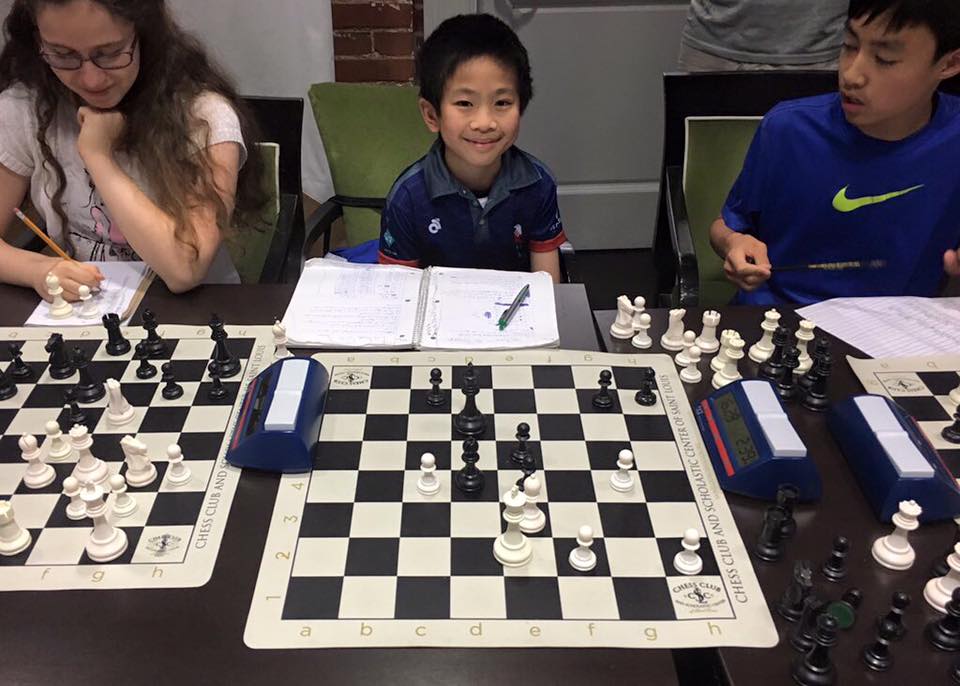 Jason Wang
Jason WangStay posted on the US Chess School on their homepage, twitter and facebook.
Categories
Archives
- December 2025 (25)
- November 2025 (29)
- October 2025 (39)
- September 2025 (27)
- August 2025 (29)
- July 2025 (43)
- June 2025 (25)
- May 2025 (24)
- April 2025 (29)
- March 2025 (29)
- February 2025 (20)
- January 2025 (24)
- December 2024 (34)
- November 2024 (18)
- October 2024 (35)
- September 2024 (23)
- August 2024 (27)
- July 2024 (44)
- June 2024 (27)
- May 2024 (31)
- April 2024 (51)
- March 2024 (34)
- February 2024 (25)
- January 2024 (26)
- December 2023 (29)
- November 2023 (26)
- October 2023 (37)
- September 2023 (27)
- August 2023 (37)
- July 2023 (47)
- June 2023 (33)
- May 2023 (37)
- April 2023 (45)
- March 2023 (37)
- February 2023 (28)
- January 2023 (31)
- December 2022 (23)
- November 2022 (32)
- October 2022 (31)
- September 2022 (19)
- August 2022 (39)
- July 2022 (32)
- June 2022 (35)
- May 2022 (21)
- April 2022 (31)
- March 2022 (33)
- February 2022 (21)
- January 2022 (27)
- December 2021 (36)
- November 2021 (34)
- October 2021 (25)
- September 2021 (25)
- August 2021 (41)
- July 2021 (36)
- June 2021 (29)
- May 2021 (29)
- April 2021 (31)
- March 2021 (33)
- February 2021 (28)
- January 2021 (29)
- December 2020 (38)
- November 2020 (40)
- October 2020 (41)
- September 2020 (35)
- August 2020 (38)
- July 2020 (36)
- June 2020 (46)
- May 2020 (42)
- April 2020 (37)
- March 2020 (60)
- February 2020 (38)
- January 2020 (45)
- December 2019 (34)
- November 2019 (35)
- October 2019 (42)
- September 2019 (45)
- August 2019 (56)
- July 2019 (44)
- June 2019 (35)
- May 2019 (40)
- April 2019 (48)
- March 2019 (61)
- February 2019 (39)
- January 2019 (30)
- December 2018 (29)
- November 2018 (51)
- October 2018 (45)
- September 2018 (29)
- August 2018 (49)
- July 2018 (35)
- June 2018 (31)
- May 2018 (39)
- April 2018 (31)
- March 2018 (26)
- February 2018 (33)
- January 2018 (30)
- December 2017 (26)
- November 2017 (24)
- October 2017 (30)
- September 2017 (30)
- August 2017 (31)
- July 2017 (28)
- June 2017 (32)
- May 2017 (26)
- April 2017 (37)
- March 2017 (28)
- February 2017 (30)
- January 2017 (27)
- December 2016 (29)
- November 2016 (24)
- October 2016 (32)
- September 2016 (31)
- August 2016 (27)
- July 2016 (24)
- June 2016 (26)
- May 2016 (19)
- April 2016 (30)
- March 2016 (36)
- February 2016 (28)
- January 2016 (32)
- December 2015 (26)
- November 2015 (23)
- October 2015 (16)
- September 2015 (28)
- August 2015 (28)
- July 2015 (6)
- June 2015 (1)
- May 2015 (2)
- April 2015 (1)
- February 2015 (3)
- January 2015 (1)
- December 2014 (1)
- July 2010 (1)
- October 1991 (1)
- August 1989 (1)
- January 1988 (1)
- December 1983 (1)







